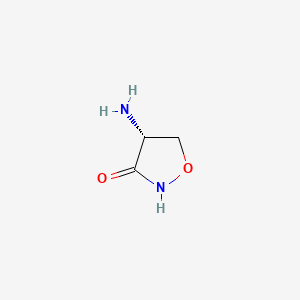| MeSH term | MeSH ID | Detail |
|---|---|---|
| Starvation | D013217 | 47 associated lipids |
| Tuberculosis, Multidrug-Resistant | D018088 | 6 associated lipids |
D-cycloserine
D-cycloserine is a lipid of Polyketides (PK) class. D-cycloserine is associated with abnormalities such as Inflammatory disorder, Asthma, Rheumatoid Arthritis, Multiple Sclerosis and Inflammatory Bowel Diseases. The involved functions are known as Cellular Infiltration, Vascular Permeability, Stimulus, antagonists and Kinase Inhibitors [MoA]. D-cycloserine often locates in Tissue membrane, Body tissue, Protoplasm, Endothelium and Cell Wall. The associated genes with D-cycloserine are Genome, serine O-sulfate, Polypeptides, alpha-aminobutyric acid, (S)-isomer and Genes, Reporter. The related lipids are Sphingolipids, Fatty Acids, Sterols, 25-hydroxycholesterol and Fatty Acids, Unsaturated.
Cross Reference
Introduction
To understand associated biological information of D-cycloserine, we collected biological information of abnormalities, associated pathways, cellular/molecular locations, biological functions, related genes/proteins, lipids and common seen animal/experimental models with organized paragraphs from literatures.
What diseases are associated with D-cycloserine?
D-cycloserine is suspected in Tuberculosis, Inflammatory disorder, Asthma, Rheumatoid Arthritis, Multiple Sclerosis, Inflammatory Bowel Diseases and other diseases in descending order of the highest number of associated sentences.
Related references are mostly published in these journals:
| Disease | Cross reference | Weighted score | Related literature |
|---|
Possible diseases from mapped MeSH terms on references
We collected disease MeSH terms mapped to the references associated with D-cycloserine
PubChem Associated disorders and diseases
What pathways are associated with D-cycloserine
There are no associated biomedical information in the current reference collection.
PubChem Biomolecular Interactions and Pathways
Link to PubChem Biomolecular Interactions and PathwaysWhat cellular locations are associated with D-cycloserine?
Visualization in cellular structure
Associated locations are in red color. Not associated locations are in black.
Related references are published most in these journals:
| Location | Cross reference | Weighted score | Related literatures |
|---|
What functions are associated with D-cycloserine?
Related references are published most in these journals:
| Function | Cross reference | Weighted score | Related literatures |
|---|
What lipids are associated with D-cycloserine?
Related references are published most in these journals:
| Lipid concept | Cross reference | Weighted score | Related literatures |
|---|
What genes are associated with D-cycloserine?
Related references are published most in these journals:
| Gene | Cross reference | Weighted score | Related literatures |
|---|
What common seen animal models are associated with D-cycloserine?
There are no associated biomedical information in the current reference collection.
NCBI Entrez Crosslinks
All references with D-cycloserine
Download all related citations| Authors | Title | Published | Journal | PubMed Link |
|---|---|---|---|---|
| Wellmann KA et al. | D-Cycloserine ameliorates social alterations that result from prenatal exposure to valproic acid. | 2014 | Brain Res. Bull. | pmid:25130667 |
| Gazarini L et al. | PTSD-like memory generated through enhanced noradrenergic activity is mitigated by a dual step pharmacological intervention targeting its reconsolidation. | 2014 | Int. J. Neuropsychopharmacol. | pmid:25539509 |
| Warmus BA et al. | Tau-mediated NMDA receptor impairment underlies dysfunction of a selectively vulnerable network in a mouse model of frontotemporal dementia. | 2014 | J. Neurosci. | pmid:25471585 |
| Rathnaiah G et al. | Generation and screening of a comprehensive Mycobacterium avium subsp. paratuberculosis transposon mutant bank. | 2014 | Front Cell Infect Microbiol | pmid:25360421 |
| Difede J et al. | D-cycloserine augmentation of exposure therapy for post-traumatic stress disorder: a pilot randomized clinical trial. | 2014 | Neuropsychopharmacology | pmid:24217129 |
| Chow SE et al. | Resveratrol induced ER expansion and ER caspase-mediated apoptosis in human nasopharyngeal carcinoma cells. | 2014 | Apoptosis | pmid:24264887 |
| Lungwitz EA et al. | The role of the medial prefrontal cortex in regulating social familiarity-induced anxiolysis. | 2014 | Neuropsychopharmacology | pmid:24157502 |
| Venir E et al. | Involvement of alanine racemase in germination of Bacillus cereus spores lacking an intact exosporium. | 2014 | Arch. Microbiol. | pmid:24346000 |
| Huang TN et al. | Tbr1 haploinsufficiency impairs amygdalar axonal projections and results in cognitive abnormality. | 2014 | Nat. Neurosci. | pmid:24441682 |
| Muscia GC et al. | Design, synthesis and evaluation of acridine and fused-quinoline derivatives as potential anti-tuberculosis agents. | 2014 | Eur J Med Chem | pmid:24412719 |
| Mpagama SG et al. | Plasma drug activity in patients on treatment for multidrug-resistant tuberculosis. | 2014 | Antimicrob. Agents Chemother. | pmid:24247125 |
| Ribbens JJ et al. | Characterization and application of a disease-cell model for a neurodegenerative lysosomal disease. | 2014 | Mol. Genet. Metab. | pmid:24094551 |
| Rothbaum BO et al. | Response to Smith. | 2014 | Am J Psychiatry | pmid:25756637 |
| Smith E | Possible negative effects of extinction learning on outcomes for patients receiving exposure therapy. | 2014 | Am J Psychiatry | pmid:25756636 |
| Rothbaum BO and Ressler K | Response to Granoff. | 2014 | Am J Psychiatry | pmid:25756635 |
| Granoff AL | The impact of benzodiazepine management in the randomized, double-blind evaluation of D-cycloserine or alprazolam combined with virtual reality exposure therapy. | 2014 | Am J Psychiatry | pmid:25756634 |
| Portero-Tresserra M et al. | D-cycloserine prevents relational memory deficits and suppression of long-term potentiation induced by scopolamine in the hippocampus. | 2014 | Eur Neuropsychopharmacol | pmid:25453488 |
| Spotlights on our sister journals: ChemBioChem 11/2014. | 2014 | Chembiochem | pmid:25045077 | |
| Fraschetti C et al. | Role of the solvent on the stability of cycloserine under ESI-MS conditions. | 2014 | J Mass Spectrom | pmid:25044845 |
| Gomes FV et al. | D-cycloserine injected into the dorsolateral periaqueductal gray induces anxiolytic-like effects in rats. | 2014 | Behav. Brain Res. | pmid:24931794 |
